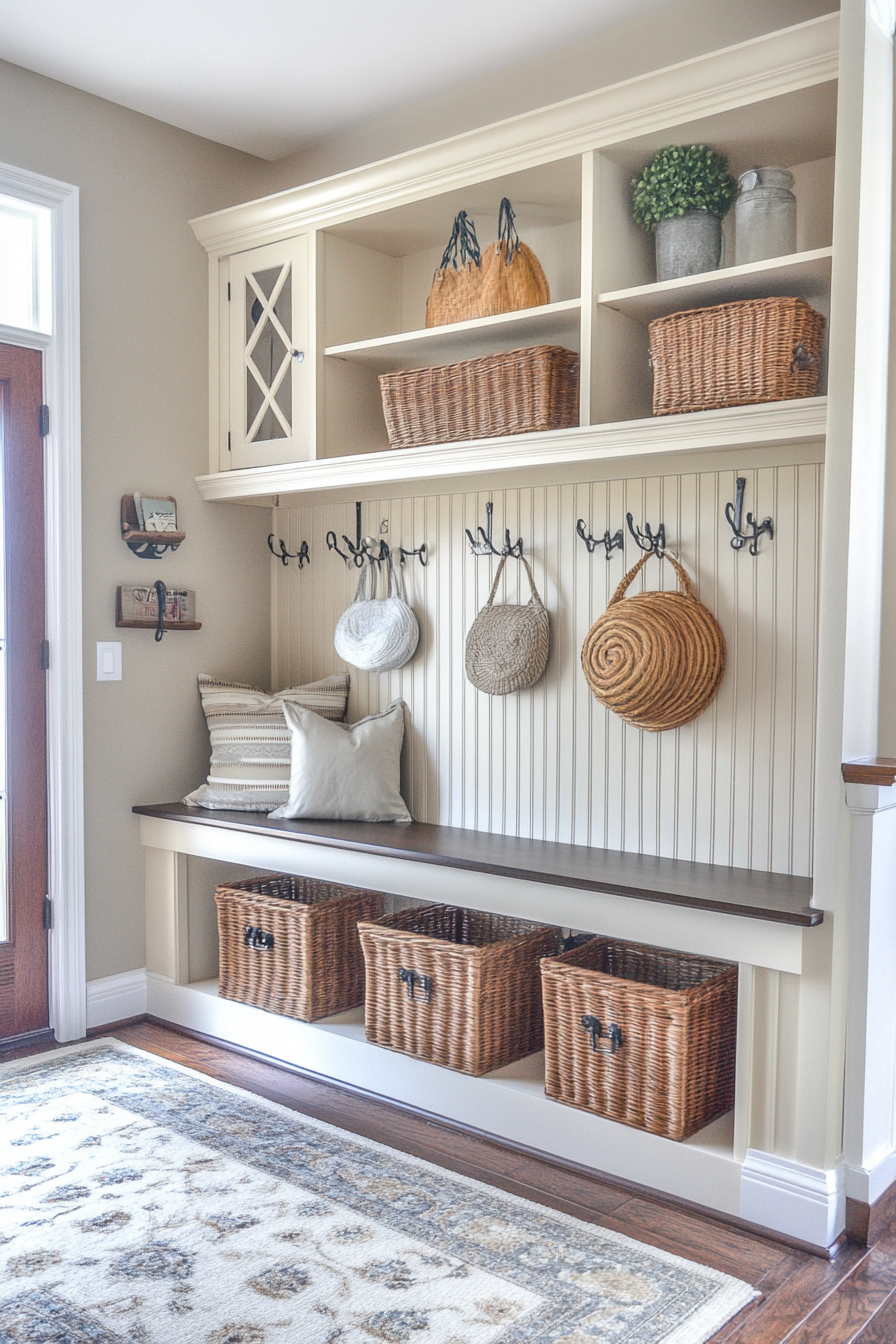Coming home should feel good, right?
But when you walk in and trip over shoes, can’t find a spot for your bag, and have nowhere to hang your coat, it’s not exactly a warm welcome!
Your entryway or mudroom is the first space you see when you get home and the last place you visit before heading out.
It deserves some attention!
Think about it – this hardworking space handles everything from muddy boots and wet umbrellas to school backpacks and grocery bags.

The best part?
A well-designed mudroom actually makes your life easier every single day.
No more hunting for keys when you’re running late!
No more piles of shoes by the door!
No more wondering where you left your wallet!
✨Click to Get My 101 FREE Designer Room Ideas
The Classic Bench and Hook Combo

Nothing beats the simplicity and functionality of a bench with hooks above it.
This setup is perfect for any entryway, big or small.
The bench gives you a place to sit while putting on or taking off shoes.
It’s especially helpful for kids or when you’re struggling with boots in winter!
Under the bench, you can add baskets or cubbies for shoes, which keeps them off the floor and organized.
Above the bench, install a row of hooks at a height that works for everyone in your family.
These hooks are perfect for hanging coats, bags, hats, and dog leashes.
For extra organization, you can label each hook with family members’ names.
Choose hooks that can handle heavy winter coats – look for sturdy metal ones that won’t break easily.
The bench itself can be as simple or fancy as you want – from a basic wooden bench to a cushioned storage bench that opens up.
If you go with a storage bench, you can hide seasonal items inside like winter gloves or summer hats.
The best material for this setup is something that can handle water and dirt – avoid fabrics that stain easily.
Wood with a good finish or metal works great for this high-traffic area.
Paint the wall behind the hooks a different color to make this area stand out as its own “zone” in your home.
This classic setup works in literally any space – even the smallest apartments can fit a narrow bench with a few hooks.
It’s also one of the most affordable mudroom solutions if you’re on a budget.
You can find ready-made bench and hook sets, or DIY it for even more savings.
If you’re handy, you can build a custom bench that fits your exact space measurements.
The beauty of this idea is that it never goes out of style – it’s been working in homes for generations!
Design a Built-In Storage Bench
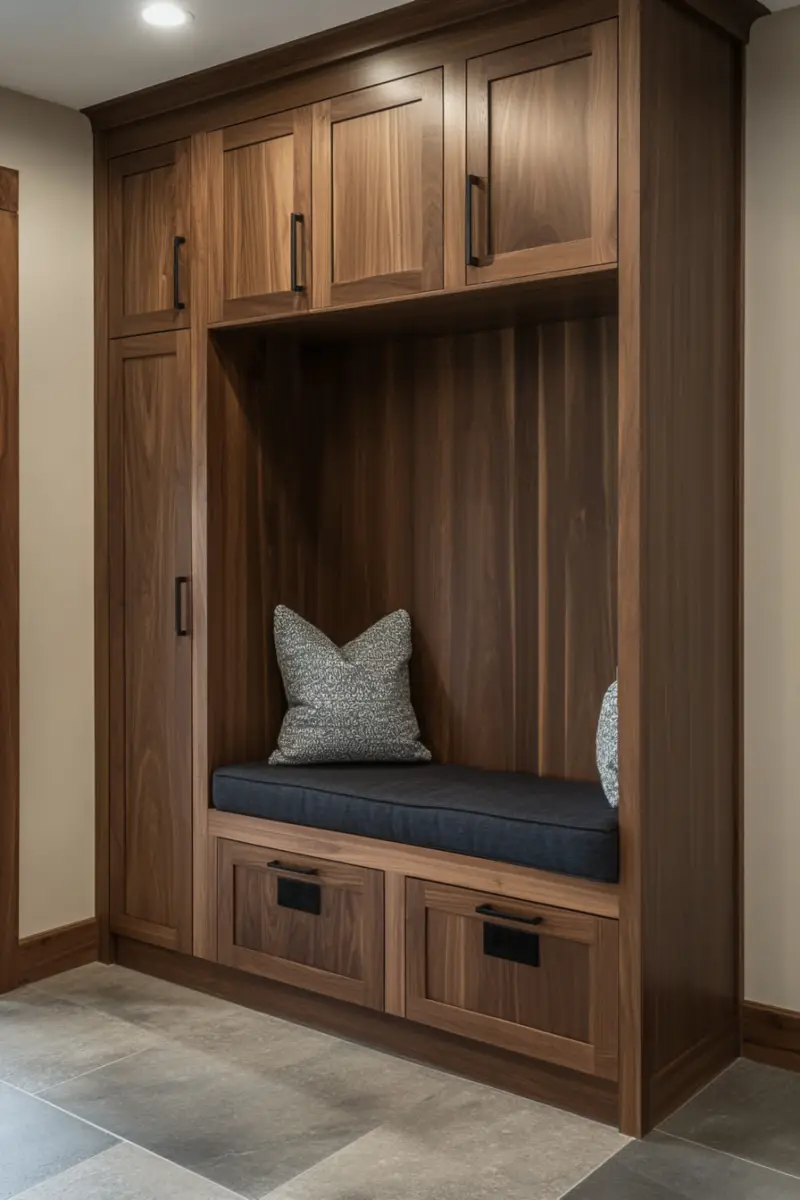
You can’t go wrong with a storage bench—it’s practical, stylish, and perfect for keeping clutter at bay.
A built-in bench gives you a place to sit while you take off your shoes, which is especially handy after a long day or on wet and snowy days.
But the real magic is in the storage underneath.
You can opt for drawers or cubbies to keep shoes, umbrellas, or even pet supplies organized.
To make it even cozier, throw in some cushions or a few decorative pillows.
Choose a durable, easy-to-clean fabric for the cushions since mudrooms tend to see a lot of wear and tear.
Paint or stain the bench to complement the rest of your home’s decor.
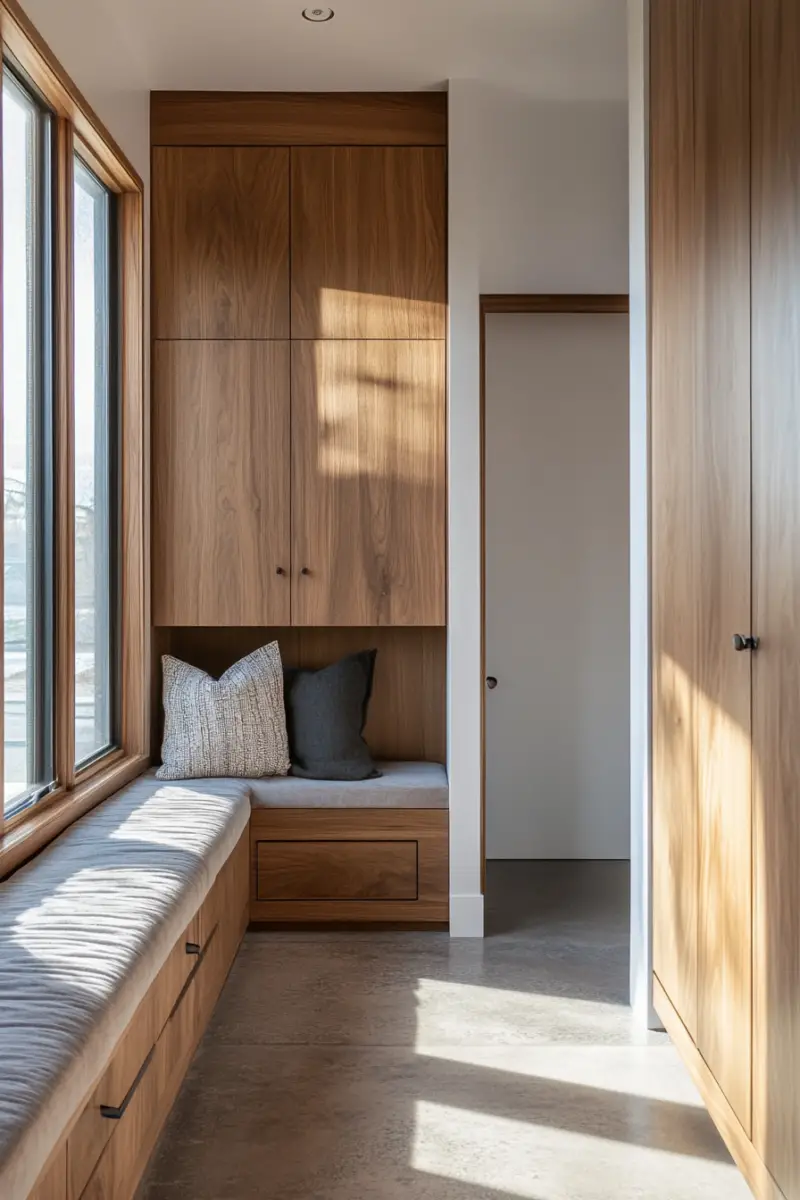
This way, your mudroom feels like an extension of your living space rather than an afterthought.
If you’re tight on space, a corner bench is a smart option.
It makes the most of awkward spaces and adds functionality without overcrowding the area.
The best part about a storage bench is its versatility.
You can customize it with hooks above for jackets and hats or add a shelf for baskets and bins.
By integrating a storage bench, you’re combining seating with clever organizational solutions.
Built-In Lockers
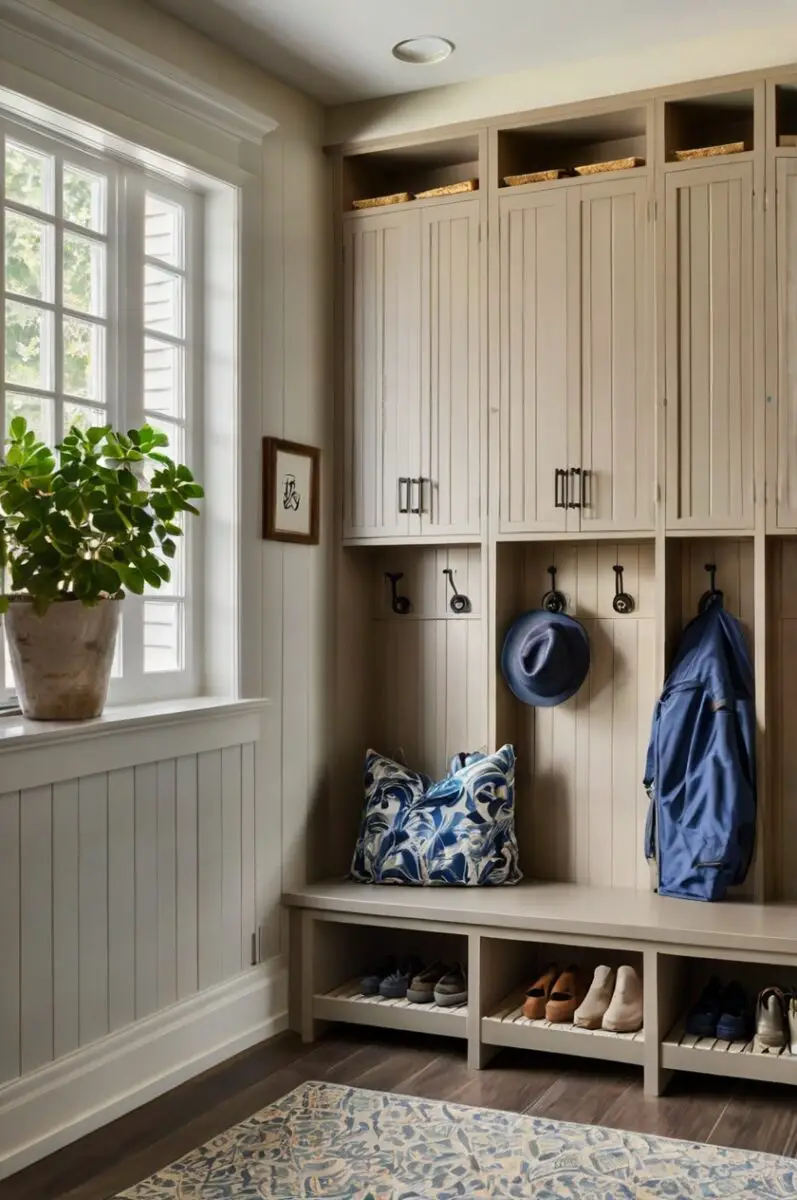
Think school lockers, but way cooler and designed for your home!
Built-in lockers are the ultimate organization solution for busy families.
Each family member gets their own dedicated space, which means no more arguments about whose stuff is whose.

These lockers can be built from floor to ceiling to maximize storage space.
Inside each locker, include hooks for coats and bags, shelves for hats and accessories, and a bottom area for shoes.
Adding doors to the lockers helps hide clutter when you have guests over.
You can paint the inside of each locker a different color to help kids remember which one is theirs.
For younger kids, put their everyday items at a lower height so they can reach them without help.
Built-in lockers can be made from wood, metal, or even repurposed kitchen cabinets.
If you’re not ready for a full renovation, you can find freestanding locker units that give you the same function.
The top of the lockers makes a great display area for seasonal decorations or family photos.
Add small baskets inside each locker for tiny items like keys, sunglasses, or winter gloves.
Installing a few electrical outlets inside the lockers lets family members charge phones or tablets.
Consider adding motion-sensor lights inside dark lockers so items are easy to find.
Label each locker clearly with names or pictures for young children who can’t read yet.
The best part about lockers is how they contain each person’s mess to their own space.
You can customize the size of each locker based on how much stuff different family members have.
Parents with lots of work gear might need bigger lockers than small children.
For pets, consider adding a special locker at the bottom for leashes, toys, and treats.
This system teaches kids responsibility for organizing their own belongings from an early age.
Incorporate a Shoe Rack for Easy Access


Let’s face it – shoes are often the biggest problem in entryways, creating piles that you trip over every day.
The right shoe storage can completely transform how your mudroom functions and looks.
Open shelving is great for everyday shoes because you can see everything at a glance.
Tilted shelves work even better because they display each pair clearly and catch dirt from the bottoms.
For boots and taller shoes, make sure some of your storage has taller compartments.
A boot tray filled with river rocks allows wet shoes to drain and dry faster.
In winter climates, consider heating elements under your shoe storage to dry wet boots overnight.
Closed cabinets with doors hide shoe clutter for a cleaner look when guests visit.
Pull-out drawers or baskets make it easy to access shoes at the back of deep cabinets.
Rotating shoe racks maximize storage in small spaces by using vertical space efficiently.
For kids’ shoes, use color-coded bins so they know exactly where their shoes belong.
Wall-mounted racks save floor space and work great for frequently worn shoes.
Over-the-door hanging organizers work well when floor space is limited.
Consider seasonal shoe storage, keeping winter boots in a different area during summer months.
Shoe storage should include a spot for dirty sports cleats that need to stay separate.
Built-in ventilation in shoe cabinets helps prevent odors from building up.
Clear shoe boxes with photos on the front work well for shoes worn less frequently.
Bench storage with hinged tops lets you hide a surprising number of shoes out of sight.
For muddy boots, create a designated “dirty zone” with washable mats and easy-clean surfaces.
A shoe horn hanging nearby encourages everyone to take off shoes properly rather than crushing the backs.
✨Click to Get My 101 FREE Designer Room Ideas
Add a Cubby System for Maximum Organization

Cubbies are a must-have if you want to create a mudroom that’s both functional and family-friendly.
They’re perfect for keeping everyone’s belongings in their own designated spot.
You can assign a cubby to each family member, making it easier to find what you need when you’re running out the door.

Label the cubbies with names or fun decals to make it even more personalized.
If you’ve got kids, this is a great way to teach them responsibility and organization.
Fill the cubbies with baskets or bins to hide clutter and keep items like gloves, hats, and scarves neatly contained.

You can also use cubbies for shoes, sports equipment, or even mail and keys.
Choose a cubby system that fits your space and needs.
Floor-to-ceiling cubbies are ideal for larger mudrooms, while a smaller unit works well in tighter entryways.
Consider using a mix of open and closed cubbies for a balance of functionality and aesthetics.

This way, you can display decorative items in the open sections and hide less attractive items in the closed ones.
Cubbies keep your mudroom looking organized while ensuring everything has its place.
Create a Drop Zone for Everyday Items

A drop zone is a total game-changer for your mudroom.
It’s essentially a dedicated spot where you can place items you use every day, like your keys, wallet, phone, or sunglasses.
No more frantic morning searches because everything is exactly where you left it!

To set up a drop zone, start with a small table, console, or even a floating shelf near the entrance.
Choose a piece that suits your space—something slim for narrow entryways or a more substantial piece if you’ve got room to spare.
Add a decorative tray or a few small baskets to corral loose items.
This keeps things contained and prevents your drop zone from turning into a chaotic pile.

You can also include a small bowl or dish for keys and coins.
If you’re someone who always needs a pen or notepad handy, keep those nearby too.
For added convenience, consider mounting a small charging station for your electronics.
This way, you can keep your devices powered up while they’re neatly stored.
To make your drop zone blend seamlessly with the rest of your mudroom, decorate it with a small plant, a framed photo, or a stylish lamp.

This touch of personality makes the area feel intentional rather than purely functional.
A drop zone not only keeps your entryway organized but also helps you maintain your daily rhythm.
Use a Rug to Define the Space

A rug in your mudroom isn’t just about aesthetics—it’s a practical addition that can completely transform the vibe of your entryway.
Choose a durable, washable rug that can stand up to dirt, moisture, and heavy foot traffic.
Look for rugs made from materials like polypropylene or indoor-outdoor fabrics that are both tough and easy to clean.

A rug helps define the mudroom space, especially if your entryway flows directly into another room.
It creates a visual boundary that makes the area feel distinct and intentional.
Pick a rug that complements your home’s color scheme or adds a fun pop of color to the space.
If patterns are your thing, go for a bold geometric design or a classic stripe to add a little flair.
Not only does a rug protect your floors from mud and scratches, but it also adds warmth and texture to the room.

For extra functionality, pair your rug with a non-slip pad underneath to keep it securely in place.
If you live in an area with lots of rain or snow, consider layering a boot tray on top of the rug near the door.
This gives people a spot to remove wet shoes without ruining the rug.
A good rug does more than just catch dirt—it ties the whole space together while keeping it practical.
Install Overhead Shelving for Extra Storage
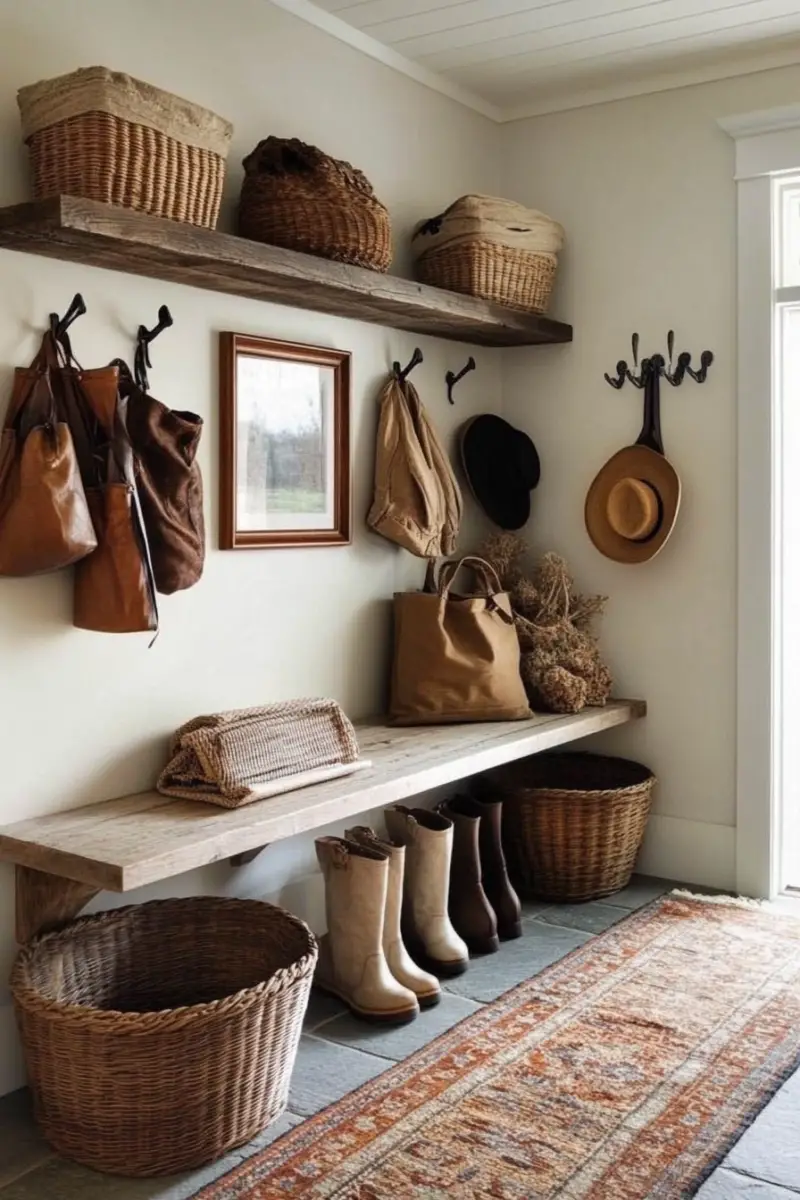
Overhead shelving is a smart way to take advantage of vertical space in your mudroom.
It’s perfect for storing items you don’t need to access every day, like seasonal gear, extra towels, or cleaning supplies.
Install sturdy shelves above your hooks, cubbies, or bench to maximize the available space.
Choose shelves that match the material or color of your other mudroom furniture for a cohesive look.
Use bins or baskets to keep items neatly contained on the shelves.
Label each bin so you always know where to find what you need.
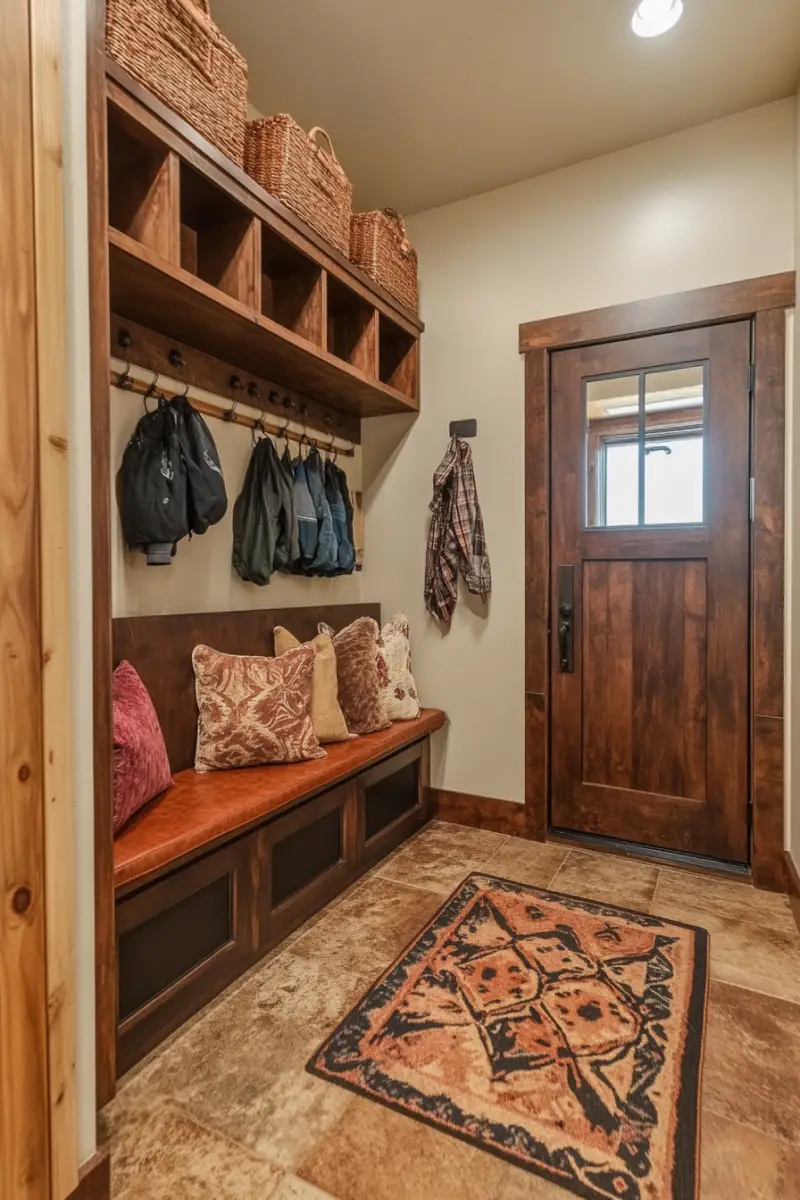
If you want to add some personality, opt for decorative storage containers that add a stylish touch to the space.
Overhead shelves are also a great place to display decorative or sentimental items.
You can add a mix of framed photos, small plants, or even books to make the mudroom feel more homey.
Just make sure to keep frequently used items within easy reach and reserve the highest shelves for things you don’t use often.
Overhead shelving is a simple but effective way to add both storage and style to your mudroom.
✨Click to Get My 101 FREE Designer Room Ideas
Include a Mirror to Brighten and Expand the Space

Adding a mirror to your mudroom is a small change that can make a big difference.
Not only does it give you a spot for last-minute outfit checks before heading out, but it also helps make the space feel brighter and larger.
Mirrors reflect light, so if your mudroom is on the smaller side or lacks natural light, this trick can instantly open it up.

Choose a mirror that fits the style of your home.
A sleek, frameless design works well in modern spaces, while a rustic or vintage frame can add character to a farmhouse-style mudroom.
If you’ve got the wall space, go for a full-length mirror.
It’s functional for seeing your entire outfit and gives the illusion of more height in the room.

For smaller mudrooms, a medium or small-sized mirror above a bench or console table looks just as stylish and serves its purpose.
You can even opt for a mirror with built-in hooks or a ledge for added functionality.
Hang the mirror at eye level for convenience, and make sure it’s securely mounted—mudrooms can be high-traffic areas, and you don’t want any accidents.
To enhance the effect, place the mirror opposite a window or light source to maximize the brightness.
A well-placed mirror doesn’t just reflect your style; it transforms the atmosphere of your mudroom entirely.
Add a Chalkboard or Whiteboard for Family Notes
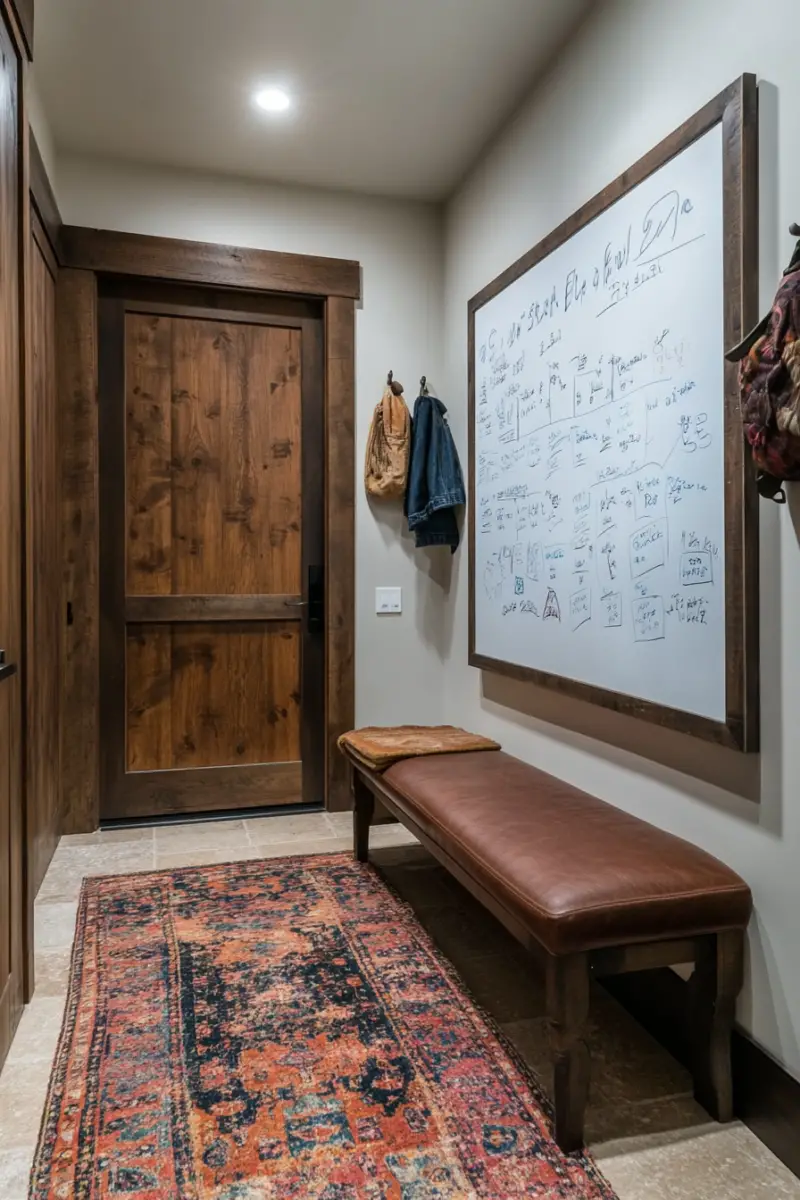
A chalkboard or whiteboard in your mudroom can be a fun and functional addition.
It’s a great way to keep track of schedules, leave notes for family members, or jot down reminders for yourself.
Mount the board on an empty wall or above a bench where it’s easily accessible.
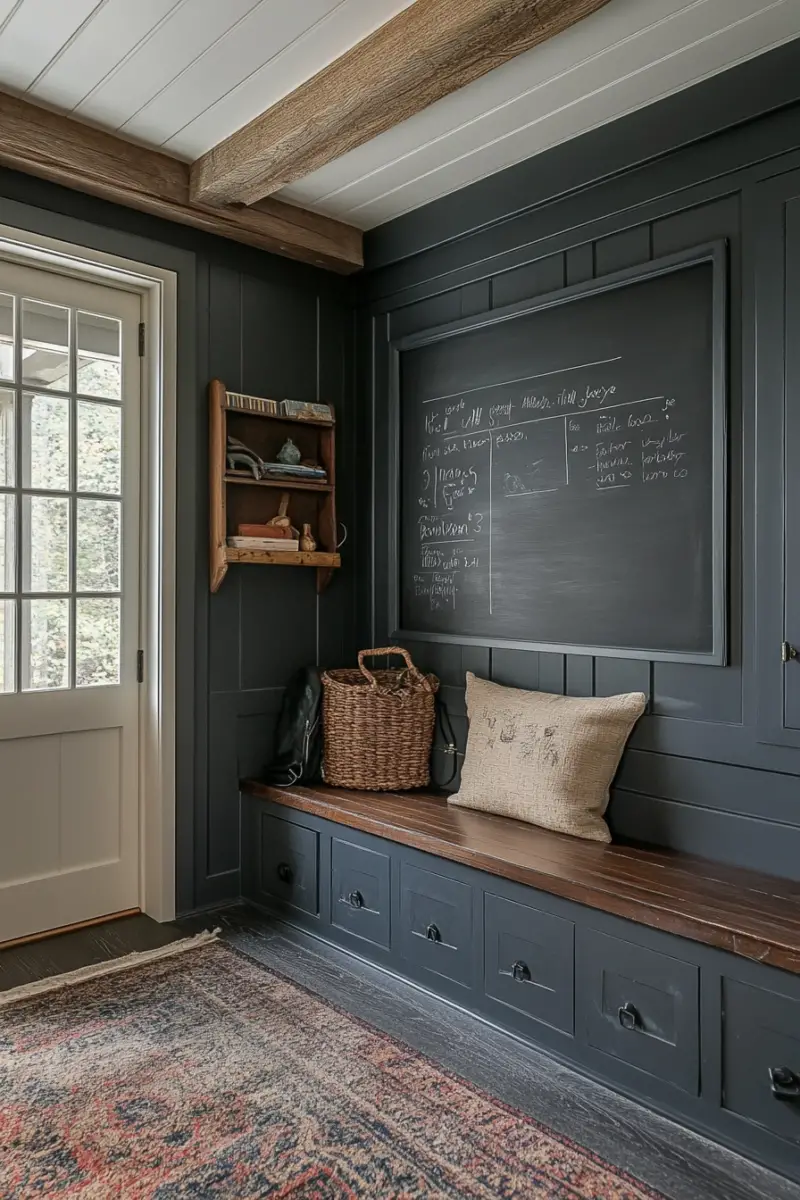
Choose a size that fits your space—the board doesn’t need to be massive to be effective.
If you prefer something more decorative, go for a framed chalkboard or a sleek whiteboard with a modern design.
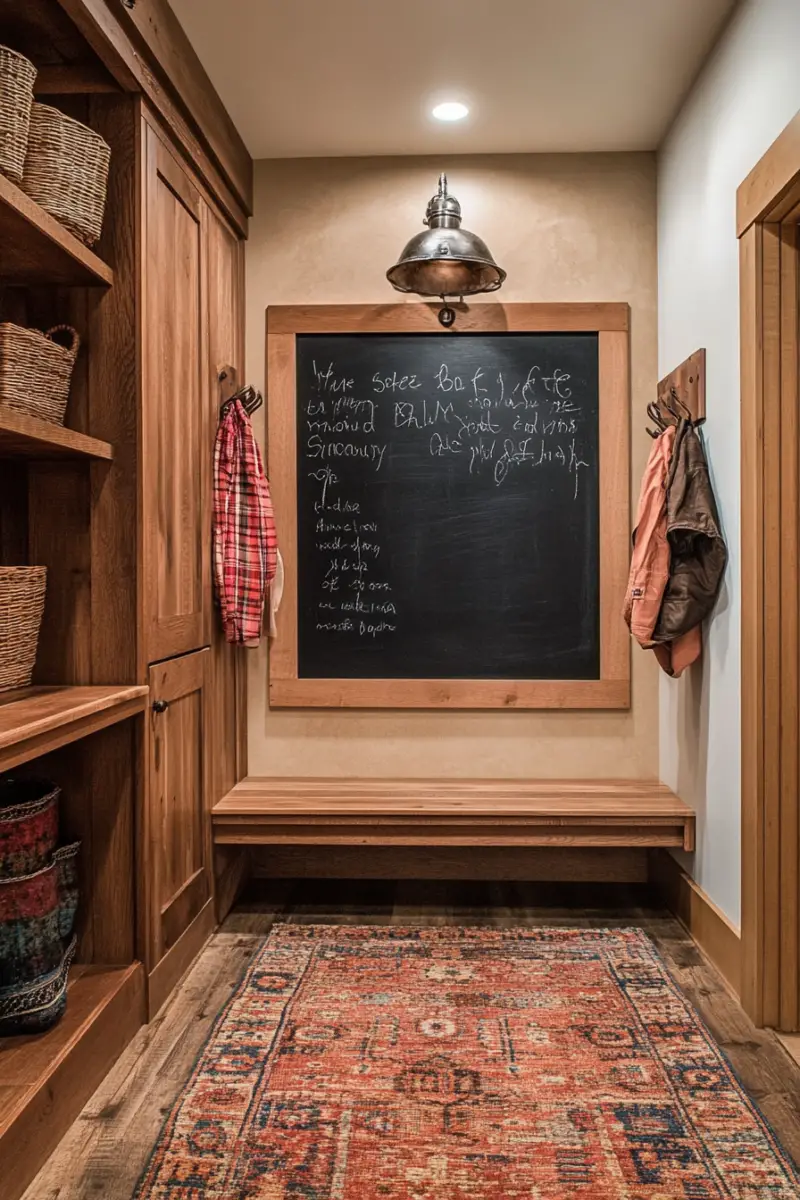
You can even use chalkboard paint to create a custom-sized writing surface directly on the wall.
Keep chalk or dry-erase markers handy in a small basket or container nearby.
This ensures that everyone has the tools they need to use the board.

Use the space for grocery lists, inspirational quotes, or even fun doodles to personalize the area.
For families with kids, this can also double as a creative space where they can draw while you’re busy organizing or coming in from outside.
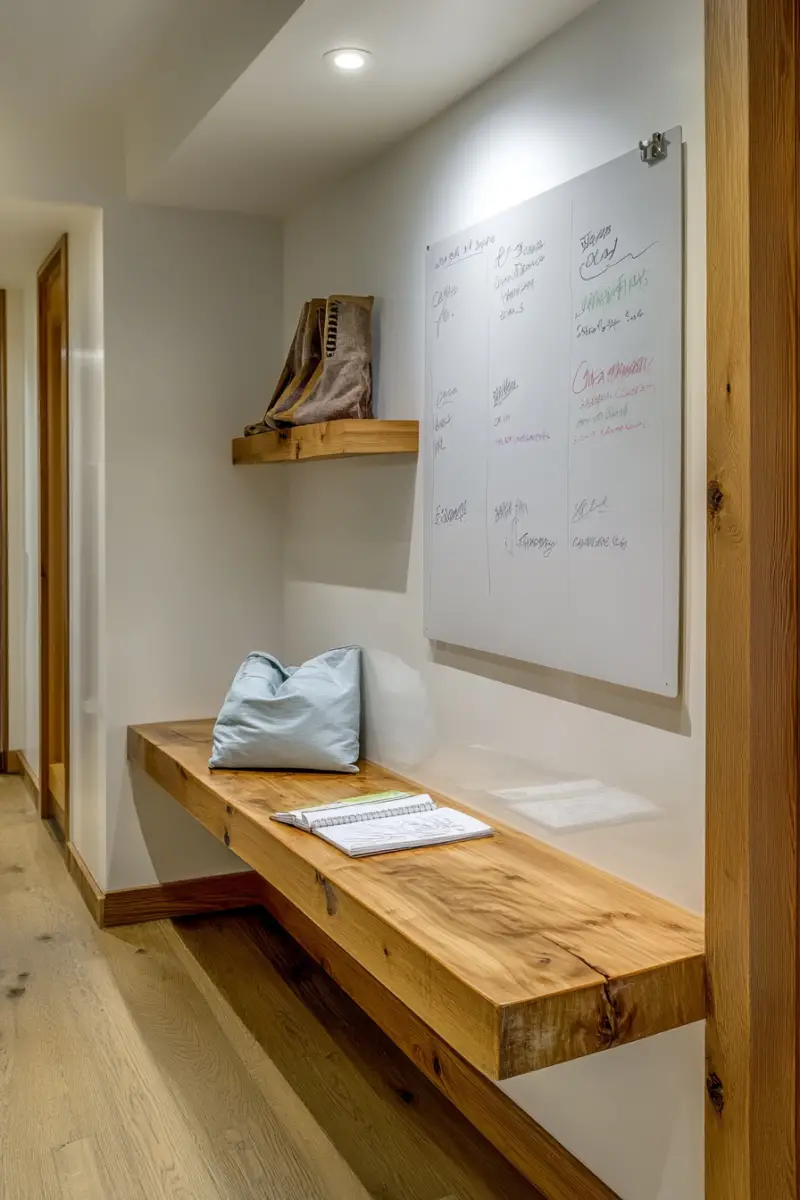
If you’re someone who loves keeping a schedule, divide the board into sections for each day of the week or assign spots for different family members.
A chalkboard or whiteboard adds personality to your mudroom while keeping everyone on the same page.
Install a Sliding Barn Door for Style and Functionality

A sliding barn door is both a stylish and practical addition to your mudroom.
It’s a great way to separate the mudroom from the rest of your home without taking up space like a traditional swinging door would.
Barn doors are perfect for homes with open layouts or small entryways where every square inch counts.
Choose a door design that complements your home’s aesthetic.

A natural wood finish adds warmth, while a painted door in a bold color can make a statement.
For a more modern look, opt for a door with a combination of wood and glass panels.
Sliding barn doors operate on a track system, so make sure you have enough wall space for the door to slide open completely.
The hardware you choose can also enhance the style—black iron tracks add a rustic feel, while brushed nickel or stainless steel suits a contemporary vibe.
Beyond the style, a barn door offers functionality.
It helps contain messes, odors, or noise in the mudroom, keeping the rest of your home peaceful and clean.
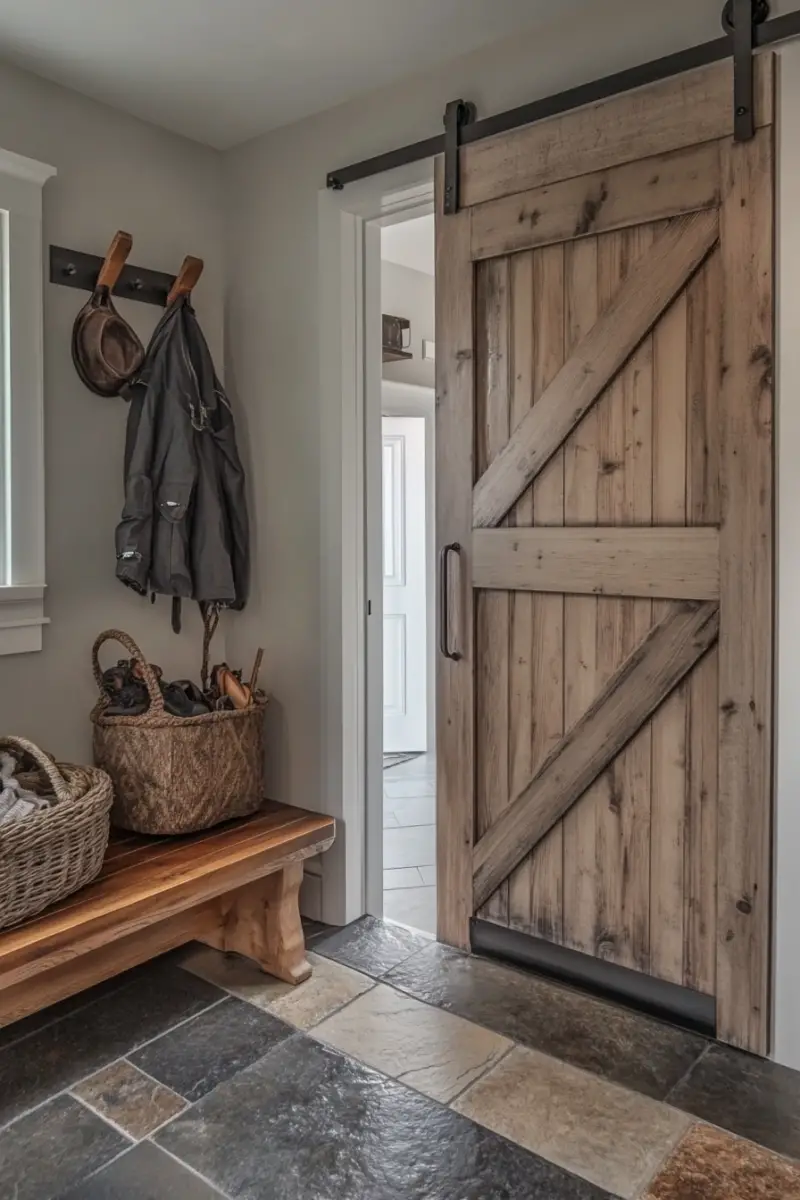
Sliding it shut after a busy day instantly hides any clutter, creating a more polished look.
A barn door is a design element that instantly elevates your mudroom while adding practical benefits to your space.
Bring in Greenery for a Fresh Touch

Plants in your mudroom?
Absolutely!
Adding greenery is a simple way to breathe life into the space and make it feel more inviting.
Choose low-maintenance plants that thrive in indirect light, like pothos, snake plants, or peace lilies.
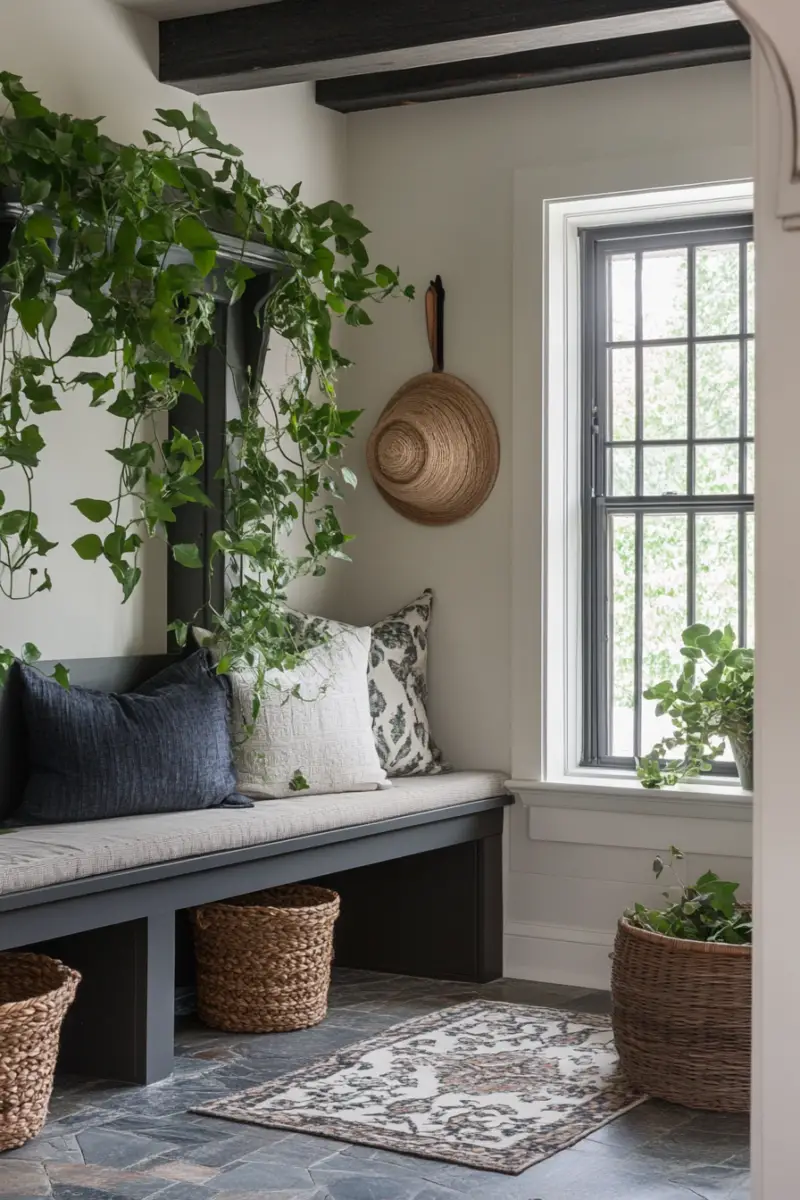
If your mudroom has a window, you can also try succulents or small ferns.
Place the plants on a shelf, next to your bench, or even hang them from the ceiling for a unique touch.
If you’re short on space, consider wall-mounted planters or small pots on hooks.
Plants not only brighten up the room but also improve air quality, which is a bonus in a space that often sees dirty shoes and wet jackets.
For an extra decorative element, use stylish pots or planters that match your mudroom’s design.
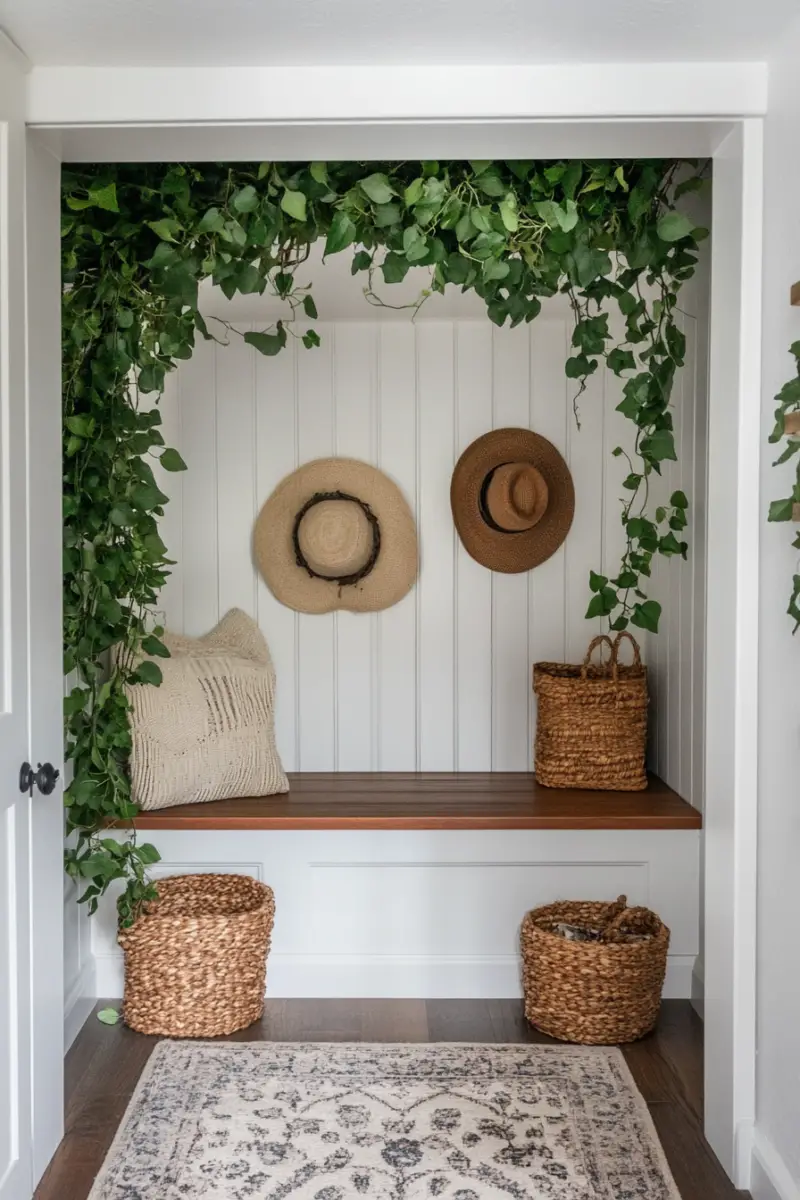
Ceramic, woven baskets, or even galvanized metal containers can add texture and personality.
If taking care of live plants isn’t your thing, there are plenty of realistic faux options that look just as good.
Greenery adds a welcoming vibe to your entryway and helps your mudroom feel less like a utility space and more like an extension of your home.
✨Click to Get My 101 FREE Designer Room Ideas
Include Personal Touches to Make It Your Own

Your mudroom doesn’t have to feel purely utilitarian—it can also be a reflection of your personality and style.
Add personal touches like family photos, artwork, or decorative signs to make the space feel more like home.

A gallery wall above a bench or hooks is a great way to display memories while keeping the area functional.

If you’re a fan of color, incorporate it through cushions, rugs, or wall paint.
You can also use patterned wallpaper to create an accent wall that makes a statement.
For a more subtle approach, choose decor and storage solutions that match your home’s overall design.
Think woven baskets, wood tones, or metallic accents.

Personal touches don’t have to be big or expensive—they just need to reflect what makes your house feel like home.

By infusing your mudroom with a bit of your style, you’ll create a space that’s not only organized but also warm and inviting.
Add Good Lighting for Function and Ambiance

Lighting can make or break the functionality and ambiance of your mudroom.
A well-lit space is essential for finding your keys, tying shoes, or cleaning up after a long day.
Start with overhead lighting, such as a flush mount or pendant light, to provide general illumination.

Choose fixtures that fit the style of your mudroom, whether it’s industrial, farmhouse, or modern.
If you have a bench or workspace, consider adding task lighting like sconces or under-shelf lights.

These add a focused beam of light where you need it most.
For a touch of warmth, include accent lighting like LED strips under shelves or around mirrors.
This creates a cozy atmosphere while enhancing the overall design.

If your mudroom has access to natural light, maximize it with sheer curtains or frosted glass panels.
Good lighting isn’t just functional—it sets the mood and makes your mudroom a place you actually enjoy spending time in.
Under-Stair Storage

Take advantage of often unused space under the stairs by transforming it into enclosed storage.
This is an excellent spot for stashing seasonal or bulky items like holiday decorations, sports equipment, luggage, coolers, and more.
If there’s enough depth, you may be able to create a long, slim closet or pantry-style space under the stairwell.
Narrow shelves, hanging rods, and slide out drawers all help maximize vertical storage.
Make sure to account for necessary headroom clearance.
For shallower under stair spots, consider neat cubbies, enclosed cabinets, or open shelving.
These options work well for shoes, outerwear, sports balls, art supplies, or even a pet area for food, toys, and bed.
Proper lighting is especially important for navigating under stair storage.
Install lighting within the space or position it to cast light inside.
Motion sensor lights add convenience.
Finishing the interior with drywall and painting provides a clean look.
The stair side can also be enclosed with doors, curtains, or cubby fronts to hide the contents.
Be sure ventilation meets code if fully enclosing the area.
Mudroom Flooring That Can Handle Everything

Your mudroom floor takes a beating from muddy boots, wet umbrellas, and everything in between, so it needs to be tough!
The perfect mudroom flooring should be water-resistant, easy to clean, and durable enough to handle heavy foot traffic.
Ceramic or porcelain tile is one of the best options because it’s practically indestructible and simple to mop clean.
Choose tiles with texture to prevent slipping when the floor is wet from rain or snow.
Large-format tiles mean fewer grout lines to clean, which is a big advantage in muddy areas.
Luxury vinyl plank (LVP) flooring is another excellent choice that’s softer underfoot than tile.
LVP looks like wood but stands up to water and mud without warping or staining.
For extra protection, consider installing radiant floor heating under tile to help dry wet boots faster.
Slate natural stone provides a beautiful, organic look that also hides dirt well between cleanings.
Concrete flooring, either polished or stained, creates an industrial look that’s practically indestructible.
If you like the warmth of wood but worry about water damage, consider wood-look tile that gives you the best of both worlds.
Indoor/outdoor carpet tiles are a budget-friendly option that can be individually replaced if one gets stained.
Whatever flooring you choose, make sure it extends fully under any benches or storage units.
Adding a sunken mat well in the floor creates a spot for a heavy-duty mat that won’t slide around.
This sunken area also helps contain water and mud to one spot rather than tracking through the house.
For ultimate durability, commercial-grade flooring materials are worth the extra cost in this hardworking space.
Dark grout is much easier to keep looking clean than white grout in a mudroom setting.
Consider floor patterns that naturally hide dirt, like mottled designs or patterns with flecks of various colors.
The transition between your mudroom flooring and the rest of your home should be seamless to prevent tripping.
Remember that your mudroom floor sets the tone for your entire home’s cleanliness, so it’s worth investing in quality materials.
✨Click to Get My 101 FREE Designer Room Ideas
Smart Drop Zones for Mail and Keys

Coming home with hands full of mail, keys, phone, and wallet?
You need a dedicated drop zone to keep these small but important items from getting lost.
A drop zone is simply a designated space where you put daily essentials as soon as you walk in the door.
The most important feature is that it must be right by the entry, before you even have a chance to wander off with your keys.
A small shelf or table works perfectly as the base of your drop zone.
Add a decorative bowl or tray specifically for keys and change.
Having a consistent spot for keys means you’ll never have to search for them when you’re running late.
Install hooks underneath a shelf to hang lanyards, ID badges, or car keys separate from house keys.
For mail, add a wall-mounted sorter with different slots for each family member.
Another mail option is labeled baskets – one for bills, one for personal mail, and one for junk that needs to be recycled.
Include a small recycling bin right at the drop zone so junk mail never makes it further into your house.
A charging station with multiple USB ports keeps phones and devices ready to go.
Make sure your drop zone has good lighting so you can see what you’re sorting through.
Adding a small mirror above your drop zone lets you check your appearance before heading out.
A bulletin board or small whiteboard in this area is perfect for family reminders and notes.
Consider adding a wall calendar here to keep track of everyone’s schedules in a visible spot.
If space allows, a small drawer helps hide clutter while keeping important items accessible.
Decorative hooks can hold sunglasses or reading glasses so they’re always easy to find.
The drop zone should be at adult height – don’t put it too low or keys will end up elsewhere.
For families, create mini drop zones for each person with their name or photo.
This area doesn’t need to be large – even a 12-inch shelf can effectively serve as a drop zone.
Bench Seating

An entryway bench provides a designated spot to sit while removing muddy shoes or outerwear.
But the mudroom bench does double duty by also offering sneaky storage space.
Look for bench styles with lift-up seats or drawers built right in.
Under-bench storage is great for stashing shoes, bags, sports gear, or seasonal accessories.
Baskets or cubbies corral smaller items.
Coat hooks mounted above the bench provide a spot to hang jackets and hats within easy reach.
For households that need lots of shoes swaps, consider a long bench or row of cubbies spanning one wall.
Multiple family members can sit together while changing footwear.
Upholstered bench tops should be durable and easy to wipe clean.
Avoid cushions that absorb moisture.
Look for quality hardwood frames and moisture-repellent fabric like faux leather.
Benches bring welcome function and comfort into the busy mudroom.
Wall-Mounted Drying Racks for Wet Gear

Living somewhere rainy or snowy?
Wall-mounted drying racks are a mudroom must-have that’ll save your floors and furniture.
These racks get wet items up off the floor where air can circulate around them for faster drying.
The best drying racks can fold flat against the wall when not in use, saving valuable space in your mudroom.
For winter gear, look for racks with wider spacing to accommodate bulky gloves and hats.
Accordion-style racks extend when needed and collapse when not in use.
Metal drying racks are more durable than plastic and can handle the weight of heavy wet clothes.
Install your drying rack above a drain or drip tray to catch water and prevent floor damage.
Some clever designs include built-in fans to speed up the drying process for really soggy items.
For families with kids in sports, look for extra-sturdy racks that can handle heavy uniforms and equipment.
Positioning the rack near a heating vent helps speed up drying time naturally.
For maximum efficiency, install multiple smaller racks rather than one large one so air can circulate better.
Consider a combination of hooks and horizontal bars for different types of wet items.
Boots and shoes dry best when positioned upside down on pegs that allow air inside them.
For delicate items like wool hats, include some mesh shelving in your drying station.
Install the rack at a height that everyone in the family can reach, with maybe some lower hooks for kids.
A boot drying rack with vertical tubes that blow warm air is worth the investment in very wet climates.
Label different sections of the drying area for different family members to avoid mix-ups.
Add a small timer nearby to remind you when items should be dry and ready to put away.
For homes with limited wall space, look for ceiling-mounted pulley systems that raise wet items up and out of the way.
The material of your wall behind the drying rack should be water-resistant, like tile or special moisture-resistant paint.
Magnetic Strip

One of the handiest items to install in your mudroom is a magnetic key strip.
This provides you with a dedicated spot to securely store your keys, where you can grab them without fumbling as you’re heading out the door.
Choose a sturdy magnetic strip made specifically for holding keys and small metal objects.
Look for one with a powerful magnetic pull that will keep keys of various sizes and weights firmly in place, even when you grab them quickly.
Measure how many hooks you’ll need based on keys used daily by family members.
Look for a strip that provides at least one hook per person, with a few extras.
Opt for one long strip or a double strip to accommodate multiple hooks.
Position the magnetic key strip near the home’s main exit where you pass through daily.
Install it at an accessible adult height, but up high enough to keep it away from young children’s reach.
Follow included directions carefully to securely fasten the key strip to the wall.
Each family member can claim one or more hooks for their own keys.
Sturdy metal hooks hold the weight of keys without sagging.
Designate spaces by labeling with names or assigning certain areas of the strip.
The magnetic pull means no more fumbling with key holders or rings!
Just place keys directly on the strip and they’ll stay put.
The powerful grip prevents keys from accidentally falling.
Keep keys organized by only placing one set per hook.
Don’t overload hooks with multiple key rings, or the weight can pull them off the wall.
Over time, grime builds up on keys from daily use and handling.
Plus hoodies, purses and bags bang against them on hooks.
Occasionally wipe down each key with a damp cloth to keep them clean.
Avoid placing small magnetic items like clips or pins on the key strip.
The magnetism makes them tricky to remove!
Reserve the strip just for keys.
The magnetic pull may gradually weaken if the strip gets bumped or shifted frequently.
Check monthly that keys are securely gripping.
Remount the strip if needed to restore full magnetism.
Mudroom Island
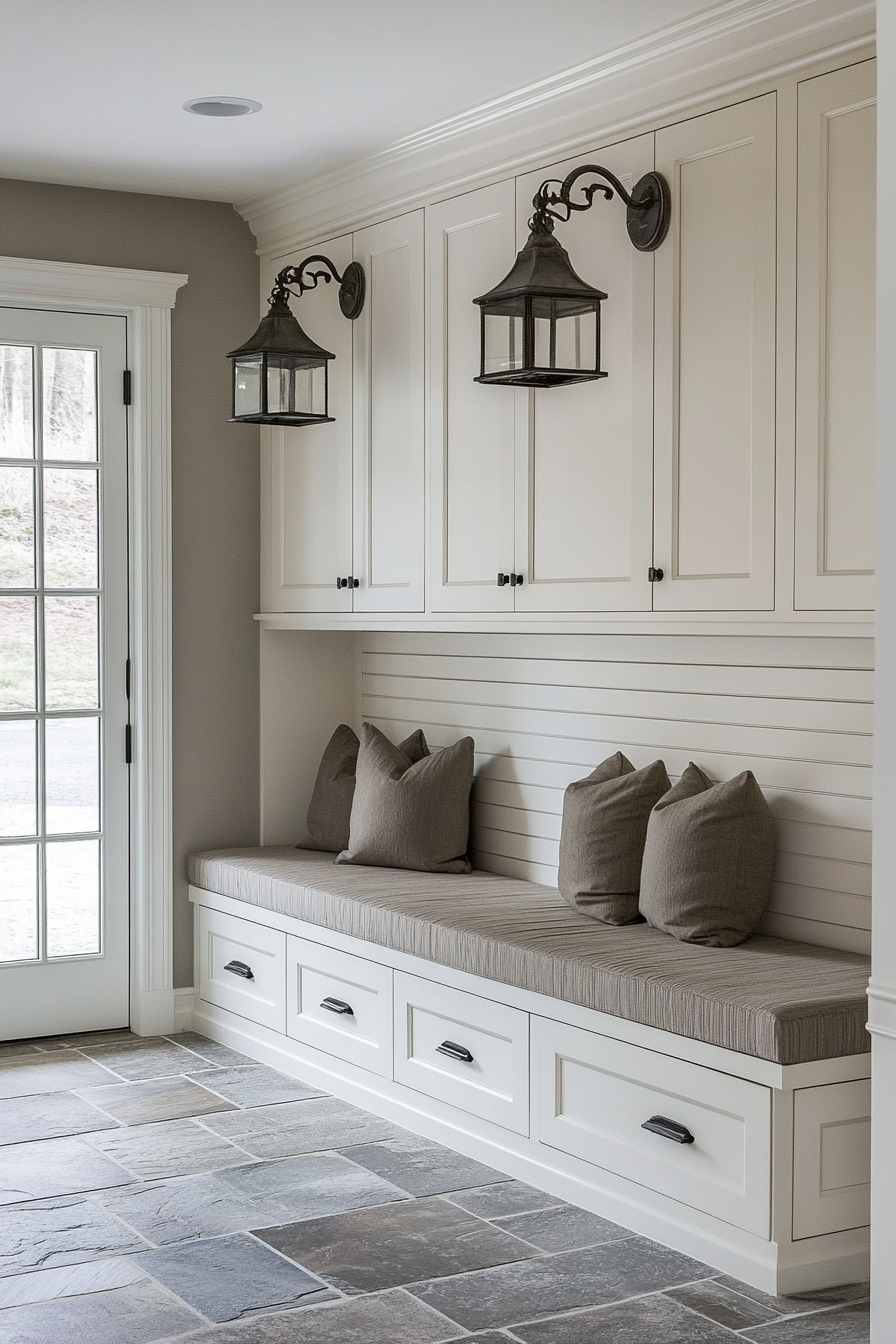
A mudroom island or work table serves multiple needs like packing lunches, charging devices, wrapping up last minute homework, or even holding the family pet’s food station.
The island anchors the space and provides extra storage and surface area.
Look for an island with shelves or cubbies to stash shoes, gloves, bags, boxes, pet food, or supplies.
Undermount drawers and cabinets offer covered storage for items you want concealed.
Opt for weather resistant woods like teak or add wood laminate to surfaces for protection against moisture damage.
Durable stainless steel islands with shelves are ideal for high traffic spaces.
Include hooks for hanging coats and bags.
Incorporate electrical outlets, USB charging ports, and task lighting.
Multi-level islands work well for defining zones – like lower shelves for pets, upper for humans.
An island on locking casters allows you to move it around to reposition as needed.
They are excellent homework stations and serve as mini buffets when entertaining.
Wallpaper Accent Wall

Don’t relegate the mudroom strictly to utilitarian storage.
Have some fun by installing a lively wallpaper accent wall.
Vibrant patterns and colors personalize the space and conceal flaws.
For best durability, choose pre-pasted wallpapers designed for high moisture areas.
Look for mold/mildew-resistant vinyl coated options that withstand liquid splashes and condensation.
Navy blue, hunter green, and chocolate browns camouflage dirt well.
But don’t be afraid to get creative with patterns and bold colors.
Geometric or abstract prints disguise messy smears.
Only wallpaper a single accent wall so the room doesn’t feel too busy.
Avoid wallpapering under cabinets or lockers where it’s visible.
Take lighting into account so colors look right.
Use removable peel-and-stick wallpaper for renters and temporary updates.
Some varieties mimic real deal wallpaper with quality prints.
But research carefully as quality varies.
Wallpaper makes it easy to refresh the mudroom every few years.
Cover existing paint or a damaged wall without extensive prep.
Just take care to install it properly for longevity.
Proper Ventilation

Between traffic in wet gear, moisture, and muddy shoe odors, air quality in the mudroom suffers.
Ensure adequate ventilation to dissipate musty smells and humidity levels that encourage mold growth.
If possible, install a window with screen to allow natural airflow.
Maximize airflow by positioning the mudroom window perpendicular to the entry doorway so breezes flow directly through.
Exhaust fans are great supplemental ventilation if a window isn’t feasible.
Cracking the door to the garage is not enough!
Remember to close interior doors to prevent mudroom odors spreading throughout your home.
Good ventilation controls humidity and prevents a smelly, clammy environment from developing.
It’s an important but often overlooked mudroom design element.
Cubicle Coat Closet
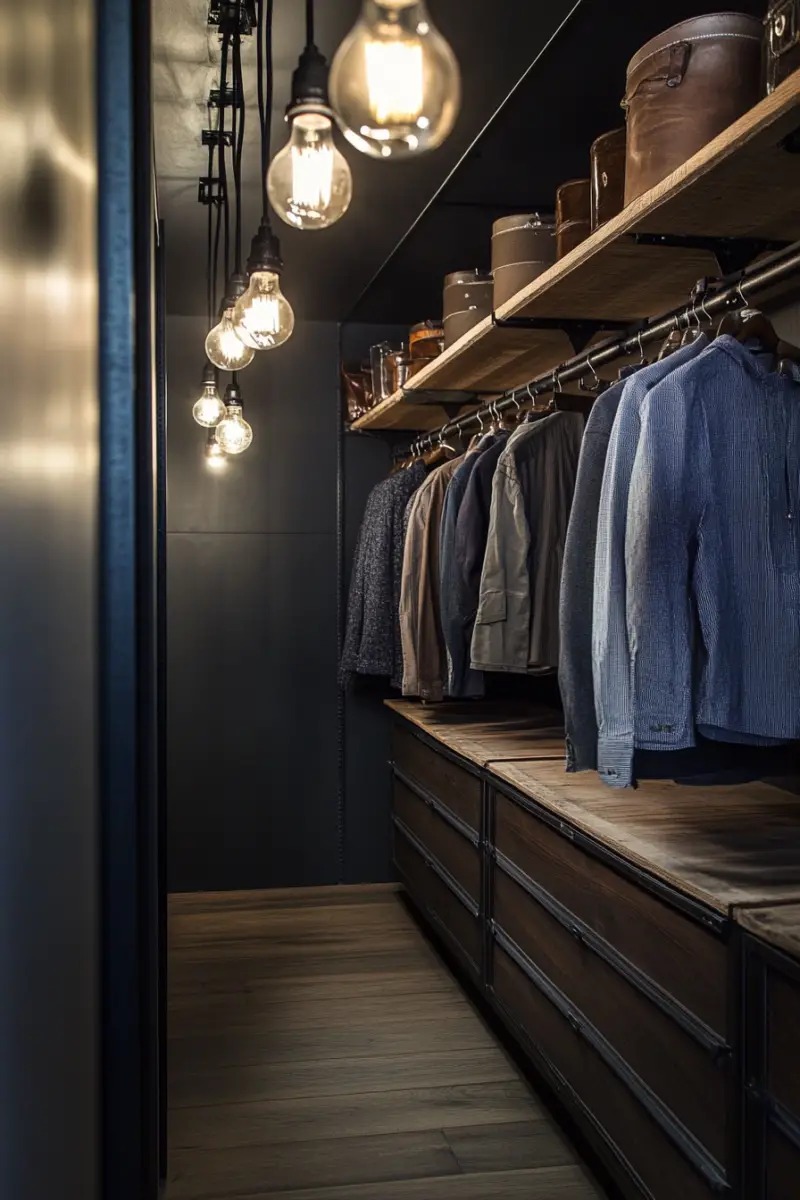
For more concealed storage beyond lockers and open cubbies, add a walk-in coat closet to your mudroom.
Unlike typical bedroom closets, optimized mudroom closets have features to handle damp, heavy outerwear and equipment.
Look for water-resistant baseboards, shelving, and hardware resistant to rust.
Use breathable metal mesh shelving rather than wood, allowing air to circulate.
Double hanging rods accommodate coats on lower and upper levels.
Have rods run edge to edge to maximize space.
Install sturdy hooks between rods for bags, hats, and gear.
The ideal mudroom closet combines hanging space with shelves above and cabinets below to make use of every inch.
Label shelves to keep order.
Use waterproof storage bins for wet items.
Install a rubber mat or drainage system to contain excess moisture on the floor.
A ventilation fan also helps actively dry the closet air and prevent odors.
For quick access to essentials, mount hooks or pegs on the back of the door to hang items within reach.
A mirror lets you check your look heading out the door.

